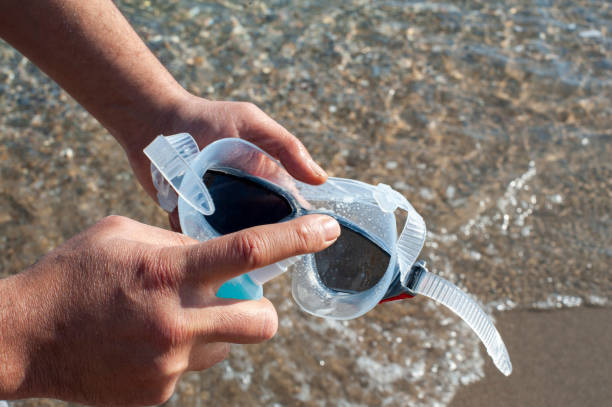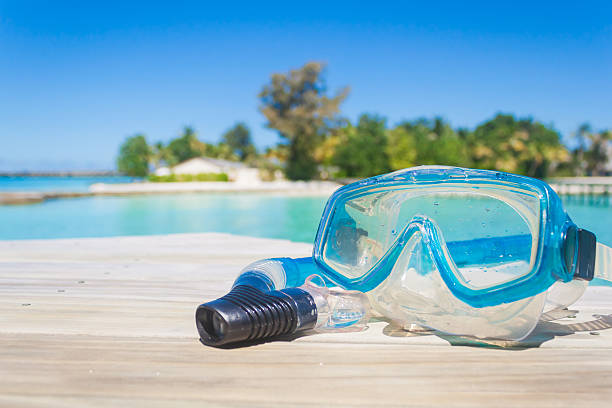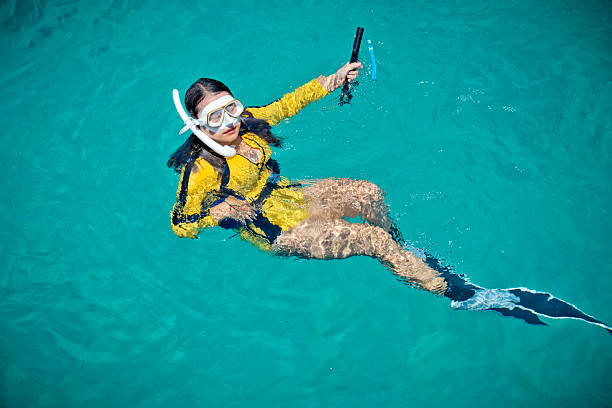At first glance, all fins may look similar—blades, pockets, and straps. But anyone who has spent real time in the water knows how dramatically design affects performance. Even a few centimeters in blade length or stiffness can change how your body moves underwater.
So let’s look closely at what truly separates freediving fins, scuba fins, and snorkeling fins, and why each design exists for its specific environment.
The Difference in Blade Length, Stiffness, and Material
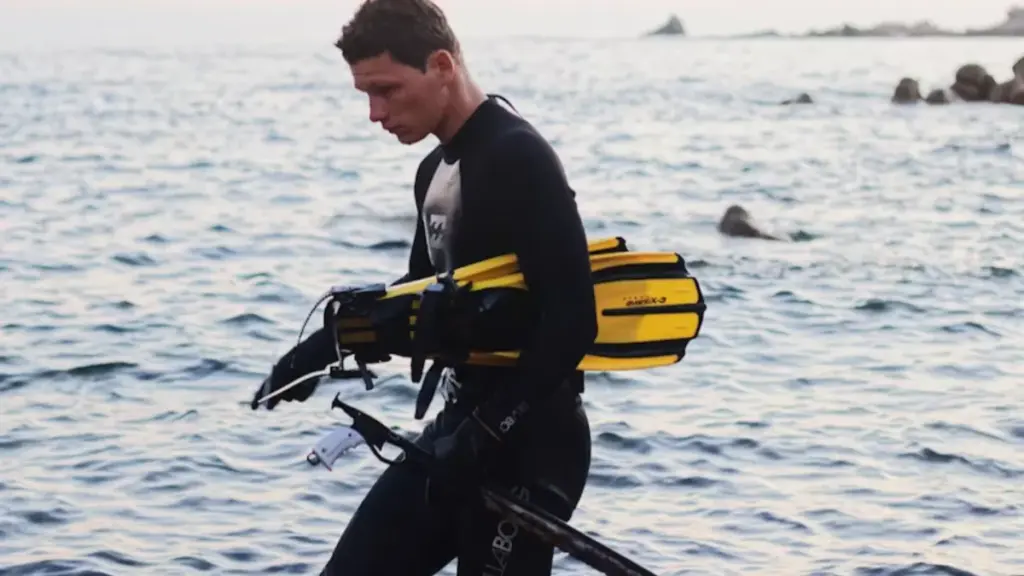
Blade Efficiency in Freediving Fins
फ्रीडाइविंग पंख are made to move you as far as possible with every kick—without wasting energy. Since you dive on a single breath, the goal is to make every movement count.
Blade Length: Extra-long, usually 90–100 cm, almost twice the size of scuba fins. The longer surface pushes more water each time you kick, giving you strong forward momentum with less effort.
Flex Pattern: The blade is firm near the foot and softer toward the tip. This helps it bend naturally and snap back with power, so you glide farther without kicking harder.
Materials:
- Carbon fiber: Super light and responsive—perfect for deep divers who want maximum efficiency.
- Fiberglass: A solid balance between flexibility and durability, great for regular training or daily use.
- Polymer composites: Slightly heavier but affordable—ideal for beginners learning freediving techniques.
The long blades help you move smoothly through the water, reducing resistance. That’s why experienced freedivers often use slow, steady kicks—the fins do most of the work for them.
Power and Stability in Scuba Fins
Scuba fins are built for strength and control. When you’re wearing 20–30 kg of gear underwater, you need fins that can handle both power and precision.
Blade Length: Medium. Around 60–70 cm, which gives the right mix of thrust and maneuverability. You get enough power to move efficiently without losing balance or control.
Flex and Structure:
- Paddle fins: Provide strong, direct kicks—great for quick acceleration or swimming in strong currents.
- Split fins: Designed with slits that channel water smoothly, making them easier on your legs during long dives.
Materials: Most scuba fins use reinforced plastics or rubber for toughness and stiffness. Some modern designs include channels or flow guides that help you move forward more efficiently.
These fins are all about control. It keeps you steady near coral reefs, inside shipwrecks, or when adjusting position underwater.
Lightweight Flexibility in Snorkeling Fins
स्नॉर्कलिंग पंख are made for easy surface swimming and relaxed exploration. They focus on comfort, light weight, and simple movement rather than deep diving performance.
Blade Length: Short and compact, usually 35–50 cm. This makes it easy to kick near the surface without tiring your legs, perfect for casual swimmers or beginners.
Flex Pattern: Soft and flexible from base to tip. The gentle bend helps you move smoothly through the water and keeps the motion easy and natural, even after long periods of snorkeling.
Materials:
- Thermoplastic elastomer (TPE): Light, flexible, and comfortable—great for everyday snorkeling.
- Polypropylene: A bit stiffer, giving slightly more power with each kick while still being easy to control.
- Silicone blends: Found in higher-end fins, combining great flexibility with a soft feel on the feet.
Snorkeling fins are all about effortless movement. Their short, flexible design helps you glide easily over reefs and calm waters, letting you enjoy the view instead of fighting against resistance. They’re made for comfort, not competition, so you can focus on the fun of exploring underwater.
Foot Pocket Types and Fit
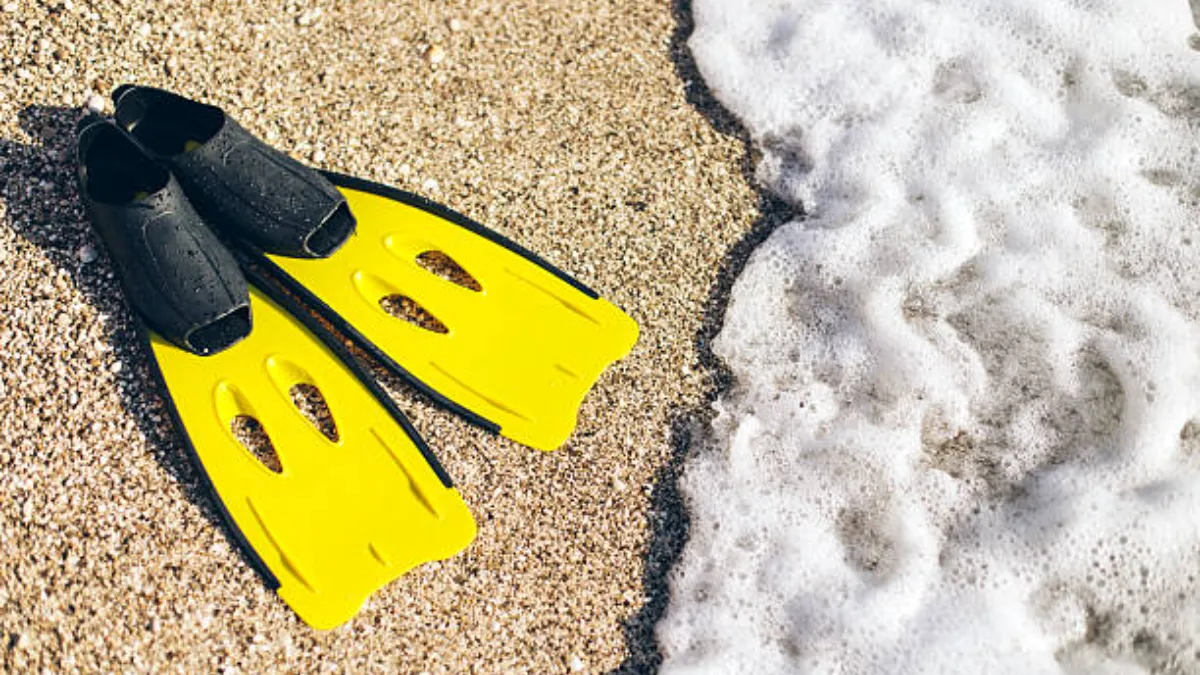
Foot Pocket Types
Different diving disciplines require different priorities: efficiency for freediving, versatility for scuba, and comfort for snorkeling.
| Fin Type | Pocket Design | Use Style | Key Advantages | Typical Drawbacks |
| फ्रीडाइविंग फिन्स | Full-foot pocket, closed heel | Worn barefoot or with thin socks | Maximum energy transfer, minimal drag | Can cause foot fatigue during surface swims |
| Scuba Fins | Open-heel pocket with adjustable strap | Worn with neoprene boots | Adaptable to boot thickness, protective on rocky entries | Slightly less efficient than full-foot designs |
| स्नोर्कलिंग फिन्स | Soft full-foot या light open-heel | Usually barefoot | Easy to wear, lightweight for travel | Less precise energy transfer, lower thrust |
फिट और आराम
Getting the right fit is one of the most overlooked—but most critical—factors in choosing fins.
A perfect fit lets your legs work efficiently without wasted motion or pain. Here’s how each type differs in feel and comfort:
फ्रीडाइविंग फिन्स
- उपयुक्त: Tight and form-hugging, designed to “lock in” around the arch and heel. This direct connection ensures every kick translates to movement.
- आराम: Moderate. Freedivers often trade comfort for performance, especially during long descents. A fin that feels slightly tight on land usually fits perfectly in the water once your feet compress under pressure.
- Expert Tip: Avoid any heel lift—it’s a clear sign of poor energy transfer. Most professional freedivers spend weeks adjusting their pocket size to find the perfect balance.
Scuba Fins
- उपयुक्त: Typically open-heel with adjustable straps or springs. The design accommodates neoprene boots for thermal protection and better grip on rocky entries.
- आराम: High. The strap system lets divers customize tightness, making it versatile for different dive environments.
- Expert Tip: Straps should feel snug but never restrictive. Over-tightening leads to calf strain and reduced thrust, while loose straps waste power in strong currents.
स्नोर्कलिंग फिन्स
- उपयुक्त: Soft and forgiving, with either a full-foot or light open-heel design. Built for casual use and easy donning.
- आराम: Very high. These fins are made for relaxed surface swimming, not deep or technical dives. Their flexible materials allow long use without fatigue.
- Expert Tip: Prioritize comfort and stability over tightness. If you can comfortably perform a few flutter kicks without slipping or rubbing, the fit is just right.
Typical Use Cases and Water Conditions
| Fin Type | Ideal Environment | Typical Depth Range | Primary Users | Key Performance Focus |
| फ्रीडाइविंग फिन्स | Open ocean, blue holes, deep vertical walls with calm or light current | 10 – 100 m | Freedivers, competitive spearfishers | Maximum propulsion efficiency and energy transfer per kick |
| Scuba Fins | Coral reefs, wreck dives, drift dives, and moderate to strong current areas | 5 – 40 m | Recreational and professional scuba divers | Power, maneuverability, and stability under heavy gear load |
| स्नोर्कलिंग फिन्स | Shallow reefs, lagoons, calm bays, and clear coastal shallows | 1 – 5 m | Casual snorkelers, beginners, resort users | Comfort, lightweight design, and surface swimming ease |
- फ्रीडाइविंग पंख
Freediving fins focus on efficiency in deep and calm water. Small changes in kick rhythm can affect speed and oxygen use. They work best when movements are slow and controlled in open, stable environments. - Scuba fins
Scuba fins are made for control under heavier gear and stronger currents. Their design supports short, powerful kicks that maintain stability and direction. They perform well in reef dives, wreck dives, and other dynamic underwater settings. - स्नॉर्कलिंग पंख
Snorkeling fins emphasize comfort and easy handling near the surface. They allow relaxed movements without tiring the legs or ankles. Ideal for calm lagoons or coastal shallows where agility and comfort matter most.
Comprehensive Comparison Table: Freediving vs. Scuba vs. Snorkeling Fins
| Feature / Aspect | फ्रीडाइविंग फिन्स | Scuba Fins | स्नोर्कलिंग फिन्स |
| Blade Length & Design | Extra-long (70–90 cm) hydrodynamic blades for maximum thrust with minimal effort | Medium-length (40–60 cm) rigid or split blades for balance between power and control | Short (30–40 cm) flexible blades for easy kicking and surface maneuvering |
| Propulsion Efficiency | ★★★★★ — highest efficiency per kick; ideal for deep vertical dives | ★★★★☆ — strong propulsion under load; reliable for horizontal movement | ★★☆☆☆ — limited thrust, suitable for short distances |
| Control & Stability | ★★☆☆☆ — less control near the surface due to blade flex | ★★★★★ — excellent control even with full dive gear | ★★★☆☆ — stable for casual surface use |
| Energy Demand | Very low at steady rhythm; optimized for oxygen conservation | Moderate; increased air consumption under heavy kicking | Low; minimal fatigue during leisure swimming |
| Weight & Portability | Heavy and bulky; difficult to pack or walk with | Medium weight; travel-friendly in shorter models | Ultra-light and compact; ideal for travel fins |
| सहनशीलता | Medium — carbon and fiberglass blades need care | High — sturdy rubber or polymer builds resist impact | Medium — soft materials may warp over time |
| Ideal Environment | Deep freediving, line diving, spearfishing | Scuba diving, drift dives, wrecks, and reefs | Casual snorkeling, resort use, warm shallow waters |
| Skill Requirement | High — requires strong finning technique and ankle strength | Moderate — manageable with basic training | Low — beginner-friendly and intuitive |
| Typical User | Performance divers, spearfishers | Recreational and professional scuba divers | Casual travelers, beginners, kids |
| Price Range (USD) | $150–500+ depending on material (carbon most expensive) | $100–300 for quality models |
How to Choose the Right Type of Fin
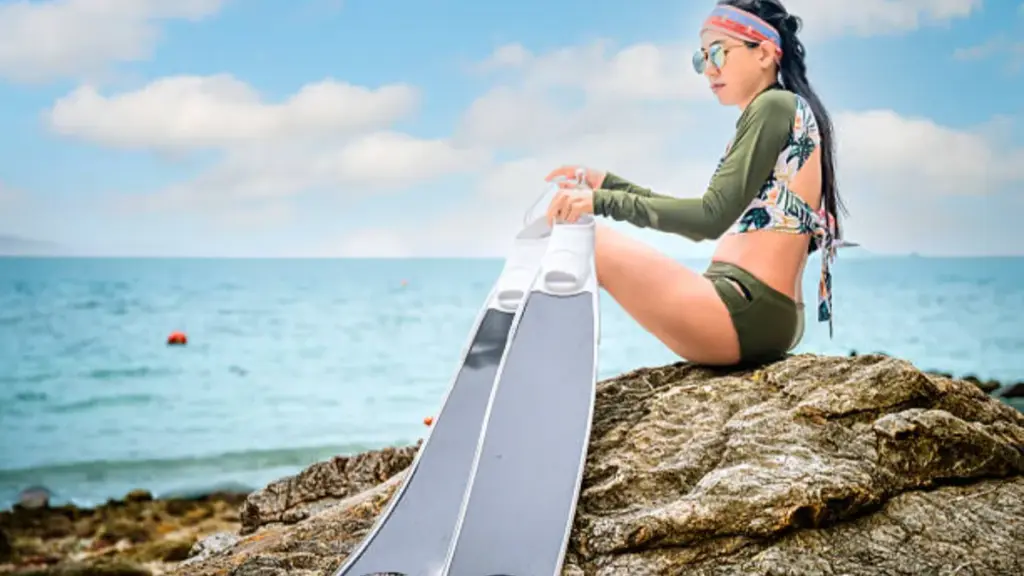
Snorkeling Fins: Comfort and Ease
For surface swimming, comfort matters most. Snorkeling fins should feel soft and flexible. This allows you to glide without tiring your legs. The foot pocket must fit snugly. Too loose, the fin may twist. Too tight, it can pinch or cause blisters. Test in shallow water. You should be able to kick for several minutes without fatigue. These fins suit beginners and casual swimmers who value ease over power.
Scuba Fins: Power and Control
Scuba fins move divers carrying full gear. They need to respond to every kick while keeping you stable. Adjustable straps ensure a secure fit with boots. Pressure should feel even across the foot. Practice turns and hovering in calm water. The fins should allow precise control. Poorly fitting fins or stiff blades can tire your legs quickly.
Freediving Fins: Efficiency and Comfort
Every movement counts in freediving. पूर्ण-पैर पंख must fit snugly but not pinch. Blade stiffness is critical. Too soft increases effort per kick. Too stiff tires calves fast. Try horizontal glides and vertical descents. The fins should feel like an extension of your legs. Proper fit and blade response make the difference between effortless dives and early fatigue.
Expert Insight
Always test new fins in calm water. Small mismatches in fit or flexibility can cause cramps or discomfort. Match fins to your kick style. Flutter kicks favor softer fins. Dolphin-style kicks favor stiffer blades. The right fin is not about brand or style. It is about how well it works with your body, goals, and environment.
अंतिम विचार
The more you dive, the more you realize that fins aren’t just accessories. They define your movement underwater. A freediver’s long blades turn each breath into range. A scuba diver’s fins turn gear-laden motion into stability. A snorkeler’s short fins turn casual curiosity into effortless fun.
If you’re sourcing or designing fins, remember that each fin type has a different performance DNA:
- फ्रीडाइविंग पंख maximize energy conversion.
- Scuba fins balance control and endurance.
- स्नॉर्कलिंग पंख emphasize comfort and accessibility.
There’s no universal “best fin.” The best one fits your environment, load, and goals—a belief shared by वेनगार्ड तैराकी, a global expert in one-stop manufacturing for swimming and diving equipment. From design to production, Vanguard delivers high-performance gear with precision and comfort, offering flexible OEM and ODM services trusted by buyers worldwide.
आज ही हमसे संपर्क करें to develop your next line of swimming and diving gear.
